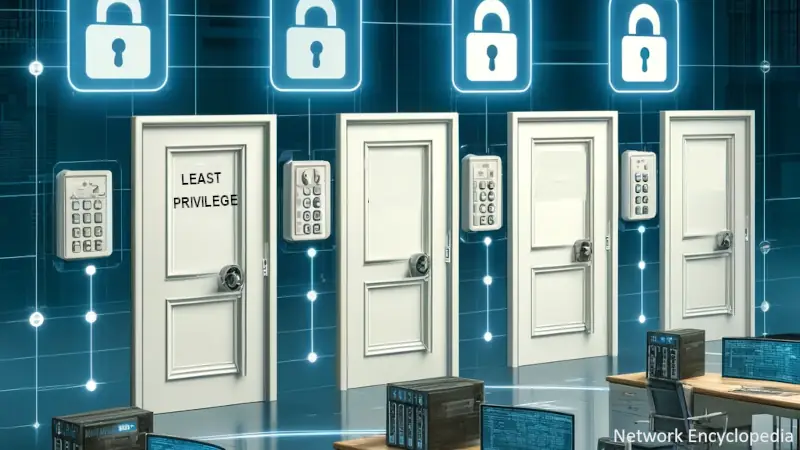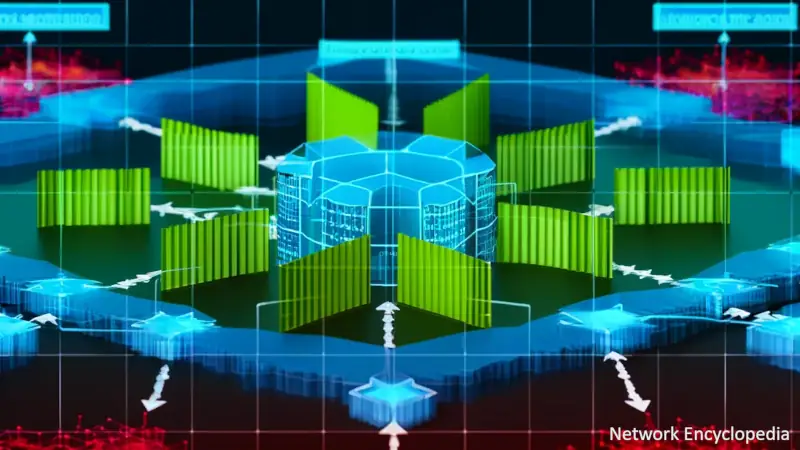In an era where cyber threats loom larger and more sophisticated than ever, the traditional “trust but verify” approach to network security no longer suffices. Enter Zero Trust Security, a paradigm shift urging “never trust, always verify.”
This article delves into the core principles of Zero Trust Security, offering a roadmap for businesses aiming to fortify their defenses against modern cyber threats. Through a detailed exploration of its foundational principles, we will uncover how Zero Trust operates not just as a technology, but as a comprehensive strategy reshaping security frameworks across industries. Prepare to transform your understanding of network security by embracing the rigor and robustness of Zero Trust.
Table of Contents:
- What is Zero Trust Security?
- The Principle of Least Privilege
- Continuous Verification and Monitoring
- Microsegmentation and Network Security
- Implementing Zero Trust Security
- References

1. What is Zero Trust Security?
Zero Trust Security is a strategic cybersecurity model that revolutionizes how organizations protect their digital environments. The fundamental tenet of Zero Trust is simple yet profound: trust no one. Unlike traditional security models that operate on the assumption that everything inside an organization’s network can be trusted, Zero Trust assumes breach and verifies each request as though it originates from an open network.
This approach demands strict identity verification for every person and device trying to access resources on a private network, regardless of whether the request comes from within or outside the network’s boundaries. At its core, Zero Trust is about minimizing risk through stringent access controls and not assuming that legacy security measures like firewalls and antivirus are sufficient on their own.

Implementing Zero Trust requires a holistic view of the security landscape. It involves understanding that there is no single perimeter to defend but rather an array of interconnected micro-perimeters, each requiring robust defense mechanisms. By adopting this model, organizations can effectively decouple their security strategy from the limitations of conventional network architectures, ushering in a new era of dynamic, adaptable, and comprehensive cybersecurity.
In the following sections, we will dissect the key principles that underpin the Zero Trust architecture, exploring how each contributes to a resilient and proactive security posture. This examination will not only highlight the necessity of each principle but also illustrate how they interlink to form a cohesive and effective security strategy.
2. The Principle of Least Privilege
The Principle of Least Privilege (PoLP) is a cornerstone of the Zero Trust model, dictating that access rights for users, accounts, and computing processes are strictly limited to only those necessary for the performance of their duties. This minimization of access rights is crucial in enhancing security by reducing the attack surface and limiting the potential impact of a breach.
At its essence, PoLP operates under a simple maxim: provide no more authority than necessary. In practice, this means that even users with administrative privileges only receive those privileges when required and for as brief a period as possible. This restricted access helps in mitigating the risks posed by both external attacks and insider threats.

Implementing the Principle of Least Privilege involves several key strategies:
- Role-Based Access Control (RBAC): Assigning permissions based on the specific role a user or entity plays within an organization ensures that they have only the access needed to fulfill their job functions.
- Just-In-Time Provisioning: Temporal limitations on access rights can prevent the accumulation of dormant privileges that might otherwise be exploited by attackers.
- Regular Audits: Periodic reviews of access rights ensure that privileges are revoked when no longer needed and adjust as roles or responsibilities evolve.
By applying PoLP, organizations can significantly minimize the potential damage from compromised credentials or insider threats. Each restricted access point acts as a barrier, reducing the number of opportunities an attacker has to exploit the network’s resources, thereby maximizing overall security.
3. Continuous Verification and Monitoring
In a Zero Trust framework, continuous verification and monitoring are imperative for ensuring that security measures are always effective and adaptive to new threats. This principle extends beyond initial access control, requiring that security checks be an integral and ongoing part of the network’s operational routine.
Continuous verification implies that trust is never granted indefinitely; instead, it must be earned repeatedly at every transaction and interaction within the network. This means re-authenticating and re-authorizing individuals and their devices each time they attempt to access resources. This dynamic approach counters the static security models of the past, where once access was granted, it was rarely revoked or reassessed.

Monitoring in Zero Trust is equally critical and involves the comprehensive observation of all network traffic and user behavior. This continuous scrutiny helps in detecting anomalies that could indicate a security breach. For instance:
- Anomaly Detection: Unusual access patterns or large data transfers can trigger alerts.
- Behavior Analytics: Leveraging user behavior data to identify deviations from normal activity patterns, which might suggest malicious intent or a compromised account.
- Automated Response Systems: When anomalies are detected, automated systems can take immediate corrective actions, such as blocking a user or quarantining a device.
The integration of continuous verification and monitoring with other Zero Trust principles creates a robust security posture that not only defends against known threats but also rapidly adapts to mitigate emerging risks. This perpetual state of alert is crucial for maintaining the integrity and confidentiality of sensitive data in today’s dynamic cyber-threat landscape. Together, these practices ensure that security does not rely on static defenses but is an active, adaptive process that responds as the network environment and threat landscape evolve.
4. Microsegmentation and Network Security
Microsegmentation is a critical strategy within the Zero Trust framework, enhancing network security by dividing larger networks into smaller, more manageable segments or zones. Each segment operates as its own secure enclave, with its specific security policies and controls tailored to the needs and sensitivity of the data within.
This segmentation of the network reduces the lateral movement of attackers within the system, a common tactic where attackers move from one compromised node to another in search of valuable data or broader network access. By limiting access between segments, microsegmentation effectively contains any breaches to a single segment, greatly minimizing the overall impact on the network.

Key benefits of microsegmentation include:
- Enhanced Security Posture: By applying strict access controls to each segment, organizations can enforce security policies that are specifically designed for the protection level required by the data in each segment.
- Reduced Attack Surface: Segregating the network into smaller zones reduces the number of attack vectors available to an adversary, thereby decreasing the overall attack surface.
- Easier Compliance Management: Segments can be configured to meet specific regulatory requirements, making it easier to comply with data protection regulations by isolating sensitive data.
Implementing microsegmentation involves careful planning and execution:
- Network Traffic Analysis: Understanding the traffic flows and interactions between resources within the network to identify logical segmentation points.
- Policy Development: Defining clear policies for each segment regarding access control, threat detection, and response actions.
- Technology Deployment: Utilizing firewalls, virtual network appliances, and software-defined networking technologies to enforce these policies effectively.
By leveraging microsegmentation, organizations can not only bolster their defensive measures but also improve their ability to monitor, control, and respond to incidents within their networks.
5. Implementing Zero Trust Security
Adopting Zero Trust Security is a strategic decision that requires meticulous planning and execution. Below are practical steps and considerations that organizations should undertake to successfully implement Zero Trust:
- Assess Current Security and Network Architecture:
- Conduct a thorough audit of existing security measures, network architecture, and data flows. Understanding current vulnerabilities and traffic patterns is crucial for planning a Zero Trust implementation.
- Identify Sensitive Data and Assets:
- Determine which data, applications, and systems are critical to the organization’s operations and require higher levels of protection. This identification will guide the prioritization of security measures.
- Implement Identity and Access Management (IAM):
- Adopt robust IAM solutions that support multifactor authentication, identity verification, and access management. These are foundational for controlling who is accessing your network and what they are allowed to do.
- Apply Microsegmentation:
- Divide the network into secure segments as discussed in the previous chapter. Define access controls for each segment based on the sensitivity and requirements of the data contained within.
- Deploy Security Technologies:
- Integrate technologies such as encryption, endpoint security, and intrusion detection systems that support the enforcement of Zero Trust principles across the network.
- Monitor and Maintain:
- Establish continuous monitoring and regular audits to ensure the effectiveness of the Zero Trust measures. Adapt and update security policies and controls in response to new threats or changes in the network environment.
- Educate and Train Staff:
- Zero Trust is as much about technology as it is about people. Educate employees on the importance of security, the specifics of the Zero Trust model, and their role in maintaining security.
6. References
Books:
- “Zero Trust Networks: Building Secure Systems in Untrusted Networks” by Evan Gilman and Doug Barth
- “Zero Trust Security: An Enterprise Guide” by Jason Garbis and Jerry Chapman
Articles / Papers:
- “Zero Trust Architecture“, by Scott W. Rose, Oliver Borchert, Stuart Mitchell, Sean Connelly, NIST (August 2020) – This document contains an abstract definition of zero trust architecture (ZTA) and gives general deployment models and use cases where zero trust could improve an enterprise’s overall information technology security posture.
RFCs: